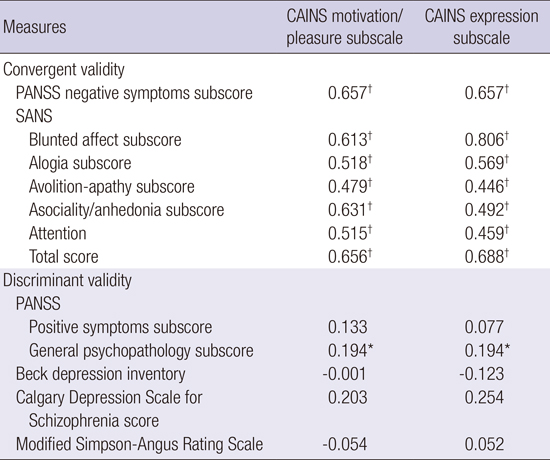1. Buchanan RW, Kreyenbuhl J, Kelly DL, Noel JM, Boggs DL, Fischer BA, Himelhoch S, Fang B, Peterson E, Aquino PR, et al. The 2009 schizophrenia PORT psychopharmacological treatment recommendations and summary statements. Schizophr Bull. 2010; 36:71–93.
2. Kirkpatrick B, Kopelowicz A, Buchanan RW, Carpenter WT Jr. Assessing the efficacy of treatments for the deficit syndrome of schizophrenia. Neuropsychopharmacology. 2000; 22:303–310.
3. Strauss GP, Harrow M, Grossman LS, Rosen C. Periods of recovery in deficit syndrome schizophrenia: a 20-year multi-follow-up longitudinal study. Schizophr Bull. 2010; 36:788–799.
4. Provencher HL, Mueser KT. Positive and negative symptom behaviors and caregiver burden in the relatives of persons with schizophrenia. Schizophr Res. 1997; 26:71–80.
5. Murphy BP, Chung YC, Park TW, McGorry PD. Pharmacological treatment of primary negative symptoms in schizophrenia: a systematic review. Schizophr Res. 2006; 88:5–25.
6. Montgomery SA, van Zwieten-Boot B. ECNP consensus meeting. Negative, depressive and cognitive symptoms of schizophrenia. Nice, March 2004. Eur Neuropsychopharmacol. 2007; 17:70–77.
7. Newcomer JW, Faustman WO, Yeh W, Csernansky JG. Distinguishing depression and negative symptoms in unmedicated patients with schizophrenia. Psychiatry Res. 1990; 31:243–250.
8. Andreasen NC. The scale for the assessment of negative symptoms (SANS): conceptual and theoretical foundations. Br J Psychiatry Suppl. 1989; 49–58.
9. Kay SR, Fiszbein A, Opler LA. The positive and negative syndrome scale (PANSS) for schizophrenia. Schizophr Bull. 1987; 13:261–276.
10. Endicott J, Spitzer RL. A diagnostic interview: the schedule for affective disorders and schizophrenia. Arch Gen Psychiatry. 1978; 35:837–844.
11. Kirkpatrick B, Buchanan RW, McKenney PD, Alphs LD, Carpenter WT Jr. The schedule for the deficit syndrome: an instrument for research in schizophrenia. Psychiatry Res. 1989; 30:119–123.
12. Blanchard JJ, Kring AM, Horan WP, Gur R. Toward the next generation of negative symptom assessments: the collaboration to advance negative symptom assessment in schizophrenia. Schizophr Bull. 2011; 37:291–299.
13. Horan WP, Kring AM, Blanchard JJ. Anhedonia in schizophrenia: a review of assessment strategies. Schizophr Bull. 2006; 32:259–273.
14. Sayers SL, Curran PJ, Mueser KT. Factor structure and construct validity of the scale for the assessment of negative symptoms. Psychol Assess. 1996; 8:269–280.
15. White L, Harvey PD, Opler L, Lindenmayer JP; The PANSS Study Group. Empirical assessment of the factorial structure of clinical symptoms in schizophrenia. A multisite, multimodel evaluation of the factorial structure of the positive and negative syndrome scale. Psychopathology. 1997; 30:263–274.
16. van der Gaag M, Cuijpers A, Hoffman T, Remijsen M, Hijman R, de Haan L, van Meijel B, van Harten PN, Valmaggia L, de Hert M. The five-factor model of the positive and negative syndrome scale I: confirmatory factor analysis fails to confirm 25 published five-factor solutions. Schizophr Res. 2006; 85:273–279.
17. Harvey PD, Koren D, Reichenberg A, Bowie CR. Negative symptoms and cognitive deficits: what is the nature of their relationship? Schizophr Bull. 2006; 32:250–258.
18. Bellack AS, Sayers M, Mueser KT, Bennett M. Evaluation of social problem solving in schizophrenia. J Abnorm Psychol. 1994; 103:371–378.
19. Strauss GP, Horan WP, Kirkpatrick B, Fischer BA, Keller WR, Miski P, Buchanan RW, Green MF, Carpenter WT Jr. Deconstructing negative symptoms of schizophrenia: avolition-apathy and diminished expression clusters predict clinical presentation and functional outcome. J Psychiatr Res. 2013; 47:783–790.
20. Blanchard JJ, Cohen AS. The structure of negative symptoms within schizophrenia: implications for assessment. Schizophr Bull. 2006; 32:238–245.
21. Kirkpatrick B, Fenton WS, Carpenter WT Jr, Marder SR. The NIMH-MATRICS consensus statement on negative symptoms. Schizophr Bull. 2006; 32:214–219.
22. Horan WP, Kring AM, Gur RE, Reise SP, Blanchard JJ. Development and psychometric validation of the clinical assessment interview for negative symptoms (CAINS). Schizophr Res. 2011; 132:140–145.
23. Kring AM, Gur RE, Blanchard JJ, Horan WP, Reise SP. The clinical assessment interview for negative symptoms (CAINS): final development and validation. Am J Psychiatry. 2013; 170:165–172.
24. Engel M, Fritzsche A, Lincoln TM. Validation of the German version of the clinical assessment interview for negative symptoms (CAINS). Psychiatry Res. 2014; 220:659–663.
25. Chan RC, Shi C, Lui SS, Ho KK, Hung KS, Lam JW, Wang Y, Cheung EF, Yu X. Validation of the Chinese version of the clinical assessment interview for negative symptoms (CAINS): a preliminary report. Front Psychol. 2015; 6:7.
26. Yu SW, Kim YS, Noh JS, Oh KS, Kim CH, Namkoong K, Chae JH, Lee GC, Jeon SI, Min KJ, et al. Validity of Korean version of the mini-international neuropsychiatric interview. Anxiety Mood. 2006; 2:50–55.
27. Koller M, Aaronson NK, Blazeby J, Bottomley A, Dewolf L, Fayers P, Johnson C, Ramage J, Scott N, West K; EORTC Quality of Life Group. Translation procedures for standardised quality of life questionnaires: the European organisation for research and treatment of cancer (EORTC) approach. Eur J Cancer. 2007; 43:1810–1820.
28. Kim MK, Lee BK, Jeon YW. Reliability of Korean brief psychiatric rating scale(BPRS): comparison of interrater reliability between the two rating methods and correlation of BPRS and SCL-90 self-report test. Korean J Clin Psychol. 2003; 22:685–698.
29. Kim YK, Won SD, Lee KM, Choi HS, Jang HS, Lee BH, Han CS. A study on the reliability and validity of the Korean version of the Calgary depression scale for schizophrenia(K-CDSS). J Korean Neuropsychiatr Assoc. 2005; 44:446–455.
30. Han HM, Yeom TH, Shin YW, Kim KH, Yoon DJ, Chung KJ. A standardization study of Beck depression inventory in Korea. J Korean Neuropsychiatr Assoc. 1986; 25:487–500.
31. Simpson GM, Angus JW. A rating scale for extrapyramidal side effects. Acta Psychiatr Scand. 1970; 45:11–19.
32. Zinbarg RE, Revelle W, Yovel I, Li W. Cronbach's α, Revelle's β, and McDonald's ω H: their relations with each other and two alternative conceptualizations of reliability. Psychometrika. 2005; 70:123–133.
33. Thompson B. Exploratory and Confirmatory Factor Analysis: Understanding Concepts and Applications. Washington, D.C.: American Psychological Association;2004.
34. Shrout PE, Fleiss JL. Intraclass correlations: uses in assessing rater reliability. Psychol Bull. 1979; 86:420–428.
35. Ahlgren P, Jarneving B, Rousseau R. Requirements for a cocitation similarity measure, with special reference to Pearson's correlation coefficient. J Am Soc Inf Sci Technol. 2003; 54:550–560.









 PDF
PDF ePub
ePub Citation
Citation Print
Print





 XML Download
XML Download